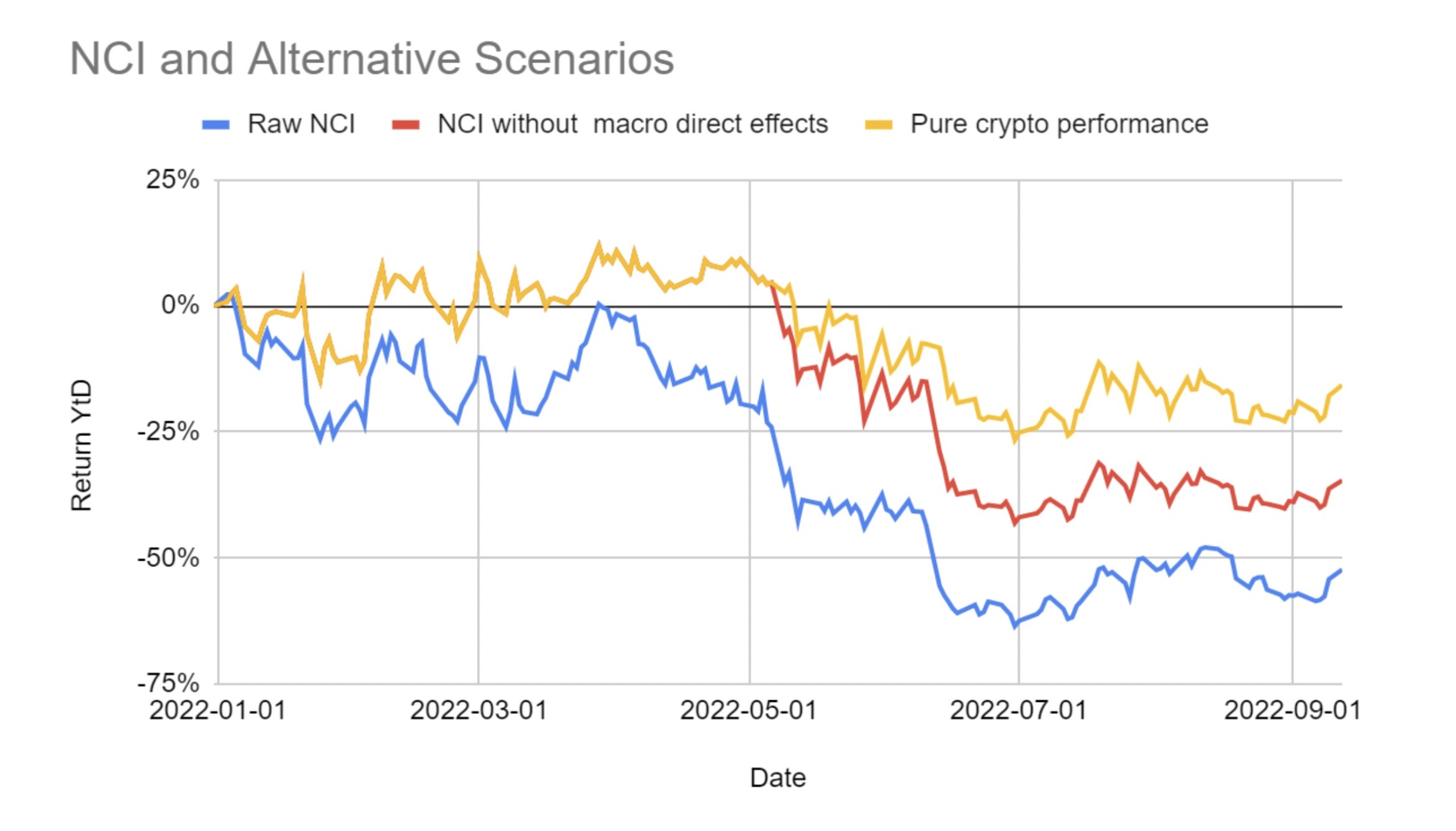Crypto’s downturn is about more than the macro environment

It’s been a tough year for risk assets across the board, and it’s fair to blame the macroeconomic situation. A combination of factors has ignited a surge of inflation in developed economies and forced central bankers to react.
As a consequence, several events — including inflation, payrolls, interest rate announcements, and speeches from monetary authorities (especially in the United States) — have had a relevant impact over the risk asset prices globally. As bad news prevailed, the turmoil spread across different asset classes and regions. By mid-September, all the main stock indexes from developed countries recorded double-digit negative returns (year to date, currency adjusted).
In these turbulent waters, crypto assets were severely harmed. The Nasdaq Crypto Index (NCI), which represents the performance of the most relevant crypto assets, had dropped 52.3% (year to date) by Sept. 12. During this crisis, crypto also exhibited an unprecedented high correlation with traditionally risky assets, notably stock in tech companies, which comprised one of the most heavily damaged sectors. Under these circumstances, it is worth questioning whether or not the crypto winter is a result of a macro scenario. Let’s see what the data can tell us.
We fitted a simple regression model to understand how macro shocks impact the NCI returns. We used the Nasdaq 100 (NDX) returns, which are highly correlated to crypto, as a proxy variable for changes in the macro landscape. Our>Terra (an algorithmic stablecoin ecosystem), and the second is June 13, the very same day when Celsius, the then-leading centralized crypto lending platform, halted withdrawals. According to the model, these two days are responsible for 22.4% drop, and the latter accounts for two-thirds of the drop.
Both Terra and Celsius are examples of classic economic disasters: a currency crisis and bankruptcy of overleveraged agents, respectively. These situations usually occur when risk aversion rises (exactly what happens during major and widespread crises). A famous quote attributed to Warren Buffett fits pretty well in describing this idea: “You don’t find out who’s been swimming naked until the tide goes out.” Although it is not fair to put all the blame on the macro environment for these events, it is hard to believe that it didn’t play a key role through accelerating the deadly spirals and amplifying the spillover effect across the rest of the crypto ecosystem. It would be fair to classify these two cases as macro-boosted crypto-specific events (what a fancy name).
After removing the effect of the two outlier dates, we land on a negative return of 15.5%, which can be labeled as pure crypto performance. Well, if you call it a winter, you probably live quite near the Equator line. The chart below shows the alternative trajectories implied by the model:

NCI and alternative scenarios. Source: João Marco Braga da Cunha
All of these statistical gymnastics are great, but what does it mean for investors who have witnessed half of the market melt down? First, in spite of the high correlation, the links between the current macro situation and the future possibilities of crypto and blockchain technologies are extremely weak. There is no reason to believe that this crisis will have an impact over the long-term outcome of crypto investments.
Second, the macro-boosted crypto-specific events that have had a substantial impact over prices were purely technical and had no effect on the foundations of the investment thesis. It is reasonable to expect that their impact will be reversed in the medium term.
Third, the crypto ecosystem is all right. The crisis washed away some bad actors and ill-designed projects, but all the pillars are standing intact. Decentralized finance (DeFi) protocols worked as expected. Ethereum just finished the most relevant update in crypto history. Second-layer solutions are evolving. There is growing adoption of nonfungible tokens (NFTs) and other forms of digital culture, and so on.
Crypto’s downturn is not all about macro. But it is likely that we would be in a comfortable autumn if it wasn’t for the crisis. And why should we be skeptical about the possibility of a crypto summer after the macro turmoil recedes? It’s been said: “To appreciate the beauty of a snowflake, it is necessary to stand out in the cold.” To get tanned in the crypto summer, you must be exposed.
João Marco Braga da Cunha is the portfolio manager at Hashdex. He obtained a master of science in economics from Fundação Getulio Vargas before obtaining a doctorate in electrical and electronics engineering from the Pontifical Catholic University of Rio de Janeiro.






 Bitcoin
Bitcoin  Ethereum
Ethereum  Tether
Tether  USDC
USDC  Dogecoin
Dogecoin  TRON
TRON  Cardano
Cardano  Stellar
Stellar  Chainlink
Chainlink  Hedera
Hedera  Bitcoin Cash
Bitcoin Cash  Litecoin
Litecoin  LEO Token
LEO Token  Monero
Monero  Cronos
Cronos  Dai
Dai  Ethereum Classic
Ethereum Classic  OKB
OKB  Algorand
Algorand  VeChain
VeChain  Cosmos Hub
Cosmos Hub  Gate
Gate  KuCoin
KuCoin  Stacks
Stacks  Tezos
Tezos  Theta Network
Theta Network  IOTA
IOTA  Tether Gold
Tether Gold  Zcash
Zcash  TrueUSD
TrueUSD  NEO
NEO  Polygon
Polygon  Decred
Decred  Dash
Dash  Ravencoin
Ravencoin  Qtum
Qtum  Basic Attention
Basic Attention  Zilliqa
Zilliqa  0x Protocol
0x Protocol  Synthetix Network
Synthetix Network  Holo
Holo  Siacoin
Siacoin  DigiByte
DigiByte  Enjin Coin
Enjin Coin  Ontology
Ontology  Nano
Nano  Status
Status  Hive
Hive  Waves
Waves  Lisk
Lisk  Steem
Steem  Numeraire
Numeraire  Pax Dollar
Pax Dollar  BUSD
BUSD  Huobi
Huobi  NEM
NEM  OMG Network
OMG Network  Bitcoin Gold
Bitcoin Gold  Ren
Ren  Bitcoin Diamond
Bitcoin Diamond  Augur
Augur